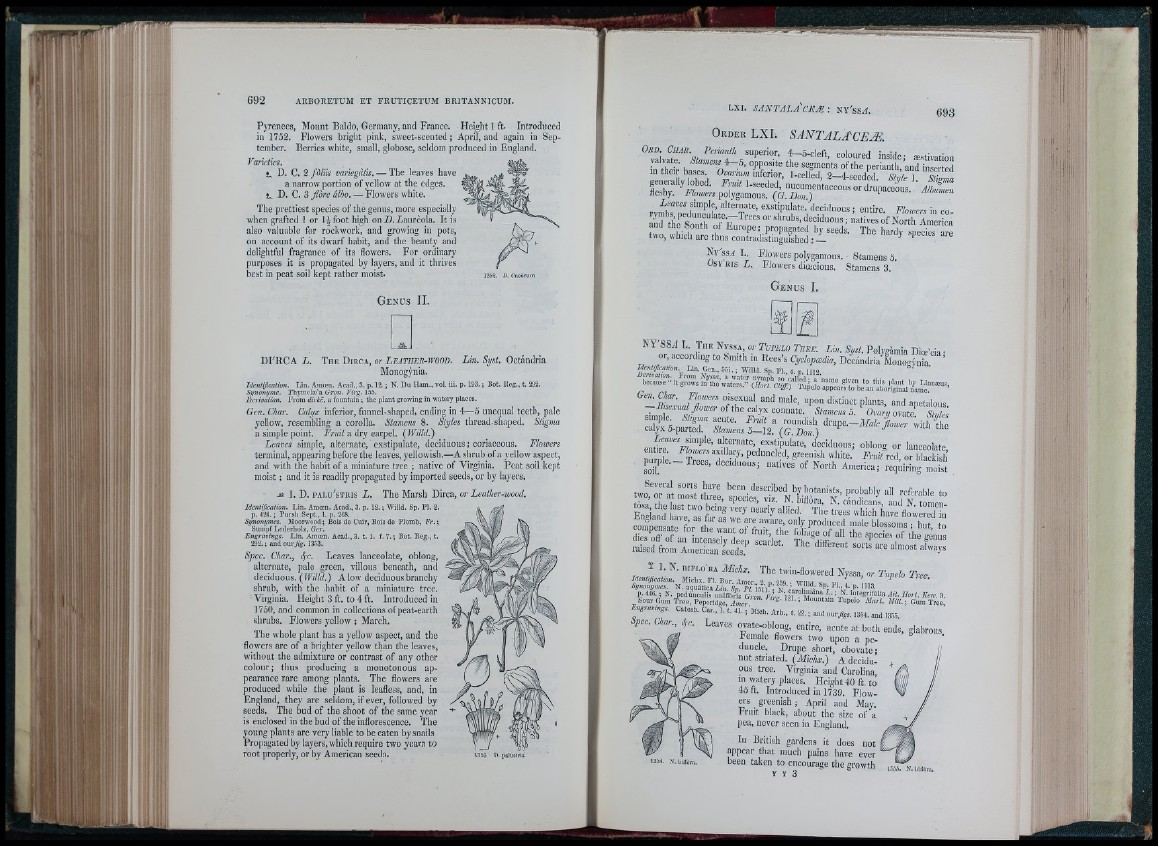
.'.'11.
i ,
; ■
3
j i k
ii| :
ira
Pyrenees, Mount Baldo, Germany, and France. Height 1 ft. Introduced
in 1752. Flowers bright pink, sweet-scented; April, and again in September.
Berries white, small, globose, seldom produced in Fngland.
Varieties.
it, D. C. 2 fdliis variegàtis. — The leaves have
a narrow portion of yellow at the edges.
D. C. 3 fo r e albo. — Flowers white.
The prettiest species of the genus, more especially
when grafted I or l^foot high on Z). Zaurèola. It is
also valuable for rockwork, and growing in pots,
on account of its dwarf habit, and the beauty and
delightful fragrance of its flowers. For ordinary
purposes it is propagated by layers, and it thrives
best in peat soil kept rather moist.
G enus II.
1362. D, Cneòvutn
v a ]
DI'RCA L . T u e D i r c a , or L e a t h e r - w o o d . Lin. Syst. Octandria
Monogynia.
Identification. Lin. Amoen. Arad., 3. p. 12. j N. Du Ham., vol. iii. p. 193. ; Bot. Reg., t. 292.
Synonyme. Thymelæ'a Oro». Virg.lhh.
Derivation. From dirkë, a fountain ; the plant growing in watery places.
Gcn. Char. Calyx inferior, funnel-shaped, ending in 4-—5 unequal teeth, pale
yellow, resembling a corolla. Stamens 8. Styles thread-shaped. Stigma
a simple point. Zn«'/a dry earpel. (Willd.)
Leaves simple, alternate, exstipulate, deciduous ; coriaceous. Flowers
terminal, appearing before the leaves, yellowish.—A shrub of a yellow aspect,
and with the habit of a miniature tree ; native of Virginia. Peat soil kept
moist ; and it is readily propagated by imported seeds, or by layers.
-Ü 1. D. PALu'sTRis L . The Marsh Dirca, or Leather-wood.
Identification. Lin. Amoen. Acad., 3. p. 12. ; Willd. Sp. PI. 2.
p. 424. ; Pursh Sept., 1. p. 268.
Synonymes. Moorwood ; Bois de Cuir, Bois de Plomb, Pr. ;
Sumpf Lederholz, Gcr.
Engravings. Lin. Amoen. Acad., 3. t. 1. f. 7 .; Bot. Reg., t.
292. ; and omfig. 1353.
Spec. Char., Leaves lanceolate, oblong,
alternate, pale green, villous beneath, anil
deciduous. (Wilìd.) Alow deciduous branchy
shrub, with the .habit of a miniature tree.
Virginia. Height 3 ft. to 4 ft. Introduced in
1750, and common in collections of peat-earth
shrubs. Flowers yellow ; March.
Tbe whole plant has a yellow aspect, and the
flowers are of a brighter yellow than the leaves,
without the admixture or contrast of any other
colour; thus producing a monotonous appearance
rare among plants. The flowers are
produced while the plant is leafless, and, in
Fngland, they are seldom, if ever, followed by
seeds. The bud of the shoot of the same year
is enclosed in the bud of the inflorescence. The
young plants are very liable to be eaten by snails
Propagated by layers, which require two yoavn lo
root properly, or by American seeds. 1353 u. iiaiustris.
6 9 3
O rder LXI. SAN TA L A 'C EÆ
m their bases. Ovarmm inferior, 1-celled, 2—4-seeded Stile 1
s ; . t e t
Leaves simple, alternate, exstipulate, deciduous ; entire Flowers in co
?id tta‘’®So?th ; natives of North America
Ny'ss^t L Flowers polygamous. Stamens 5.
U SY E i s L . Flowers t l ioe c i o u s . Stamens 3 .
G enus I.
NY'SSrt L. Tue Nyssa or T upjilo Thee. Lin. Syst. Polygàmia Dice'cia •
01, according to Smith tn Rees’s Cyclopaedia, Decándria Mono-ynia ‘ ’
Identification. Lin. Gen., 55i. ; Willd. Sp. Pl 4 p 1112
t e ’t e r ô r a p G . -M a , e % w e r i J X :
"i/™ate, exstipulate, deciduous; oblong or lanceolate
Mrnk a/llary, peduncled. greenish white. Fruit red, or blackish
purple.-Tre es, deciduous; natives of North America; requiring mokt .
tw o T 'a t t t e te ." re™ I> « '" y l) /a n is ts , probably all referable to
tósa the last two being v ? r ÿ ? t e 'allied.' T h e L c Ï l ^ r h a T f l o w t e n '
ï 1. N. B IF L O R A Michx. The twin-flowered Nyssa, or Tupelo Tree
r rig. lífffSiSSái'aSpS:
:r,ngs. Catesb. Car., 1. t. 41. t Miel,. Arb., t. 22. ; and o u r * s . 1
f. 13.54. and J3.5.5.
Spec. Char., "Leaves ovate-oblong, entire, acute at both ends, glabrous
female flowers two upon a peduncle.
Drupe short, obovate;
nut striated. (Michx.) A deciduous
tree. Virginia and Carolina,
in watery places. Height 40 ft. to
43 ft. Introduced in 1739. Flowers
greenish ; April and May.
Fruit black, about the size of a
pea, never seen in England.
1364. N. biflòr.T.
In British gardens it does not
appear that much pains have ever
been taken to encourage the growth
Y V 3
1356. N. billòra.
l i l i 4 :